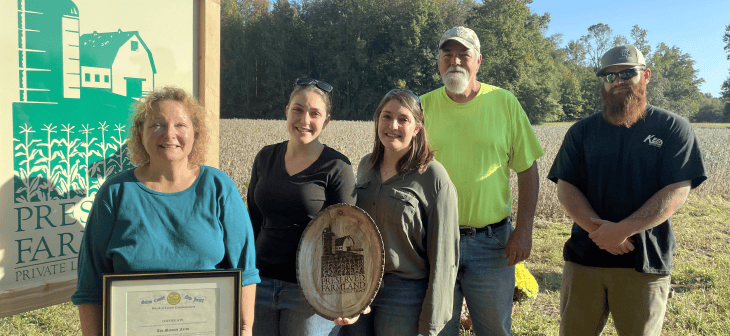by Tom Gilbert, Co-Executive Director, New Jersey Conservation Foundation
For a small state, New Jersey is a big producer of fruits and vegetables. We earn our “Garden State” nickname by ranking in the top 10 nationally for many crops, including eggplant, tomatoes, cranberries, spinach, bell peppers, asparagus, squash, peaches, cucumbers, blueberries, and sweet corn.
Perhaps it’s no coincidence that New Jersey also ranks very high, compared with other states, in the amount of farmland it preserves. In a 2020 report, the American Farmland Trust found that New Jersey has responded better than any other state to the major threats to agricultural land: development pressure, weakening agricultural viability, and the transfer of land from aging farmers to a new generation.
Our farmland preservation program reached a new milestone in October when it surpassed 250,000 acres permanently preserved. That milestone was achieved by preserving the 134-acre Mecouch Family Farm in Quinton Township, Salem County.
With that milestone – celebrated with an event hosted by the Mecouch family at their farm – over one-third of New Jersey’s approximately 750,000 acres farmland has been permanently preserved. The state is now about halfway to its goal of preserving at least 500,000 acres of farmland.
“New Jersey is enormously grateful to both farmland owners who decide to preserve their land, and who leave behind a great conservation legacy, and to the thousands of farmers who work these lands to provide New Jersey residents access to fresh, locally grown food and farm products,” said Susan Payne, executive director of the State Agriculture Development Committee (SADC), the agency that runs the program.
The event at the Mecouch farm also celebrated the 40th anniversary of the legislation that established the agricultural easement purchase program to protect farmland in perpetuity.
In 1983, Gov. Thomas Kean signed into law the Agriculture Retention and Development Act, as well as the Right to Farm Act, which protects farmers from unreasonable local ordinances and private nuisance actions – for example, targeting noise from farming equipment.
Later, the state introduced its popular Jersey Fresh program – widely imitated by other states – to encourage consumers to buy New Jersey produce and farm products.
Farmland preservation efforts ramped up in 1998 when Gov. Christine Todd Whitman established the Garden State Preservation Trust as part of an ambitious plan to preserve a million acres of open space and farmland. State spending on farmland preservation jumped from $15 million a year to about $80 million.
Funding for Whitman’s million-acre program expired after a decade, but in 2014 New Jersey voters passed a ballot measure dedicating a percentage of the state’s corporate business tax revenue toward preserving open space, farmland and historic properties. This ensures a steady and stable source of funding, eliminating the need for a new ballot referendum every time land preservation funds ran out. Unfortunately, the amount of funding available each year for farmland, open space and historic preservation will take a big hit unless the governor and legislature extend a surcharge on the Corporate Business Tax that is set to expire at the end of this year.
Some New Jersey farmland is preserved directly by the state, but very often SADC funding is matched by federal, county and municipal farmland preservation funds. Many conservation nonprofits, including New Jersey Conservation Foundation, also regularly partner with the state on farmland preservation projects.
Although New Jersey is considered a highly urbanized state, it’s notable that farmland has been preserved in 18 of our 21 counties.
Salem County is the state’s undisputed farmland leader, with 408 preserved farms covering 43,341 acres in 12 municipalities. Hunterdon is second in preserved acreage, with 466 farms covering 36,075 acres in 19 municipalities; Burlington is third, with 245 farms covering 29,642 acres in 21 municipalities.
Only the state’s three most urban counties – Essex, Hudson and Union – have no preserved farmland. But their residents have certainly benefited from the state’s farmland preservation, judging by the popularity of dozens of farmers markets within the three counties.
Let’s hear it for New Jersey’s farmland preservation program, which is helping to protect our supply of fresh, local foods for generations to come! Without this program, an unthinkable amount of our best agricultural land would have been gobbled up for housing, offices, shopping centers, and warehouses.
But let’s not forget that protecting farms and locally-grown foods isn’t just about acreage – it’s also about protecting the most fertile soils. Not all soil is created equal, and it’s vitally important to make sure the very best quality soils for agricultural production aren’t lost or destroyed.
To that end, the SADC has proposed a set of soil protection standards for preserved farmland that would limit the amount of soil disturbance permitted outside of routine tilling. It’s a step in the right direction – as well as one mandated by a state Supreme Court ruling – and it will ultimately benefit all New Jerseyans!
To learn more about New Jersey’s farmland preservation program, go to https://www.nj.gov/agriculture/sadc/farmpreserve/. To read the American Farmland Trust’s “Farms Under Threat” report, go to https://farmland.org/project/farms-under-threat/.
And for information about preserving New Jersey’s land and natural resources, visit the New Jersey Conservation Foundation website at www.njconservation.org or contact me at [email protected].

